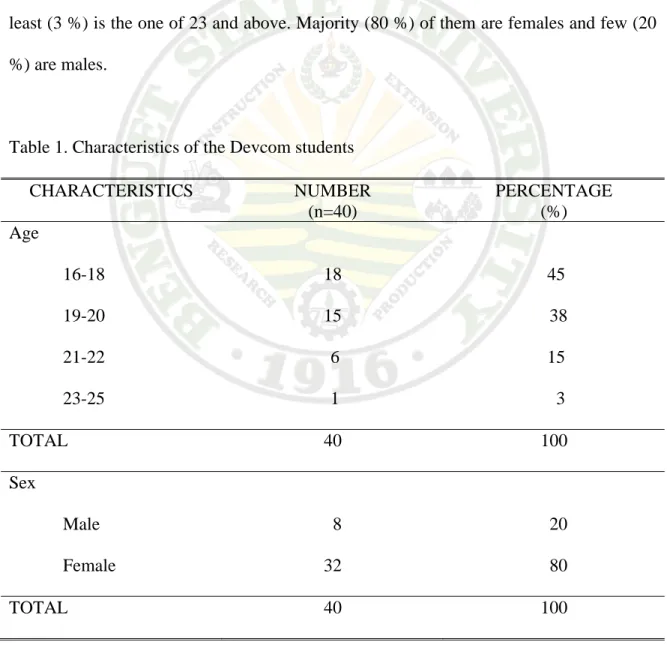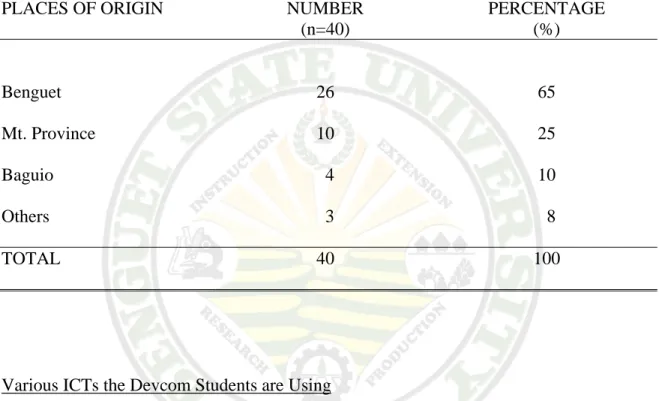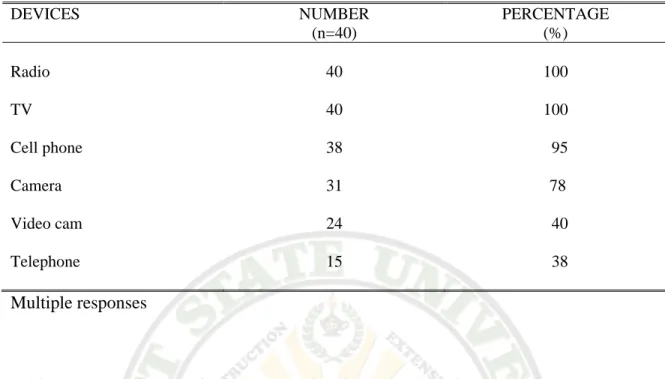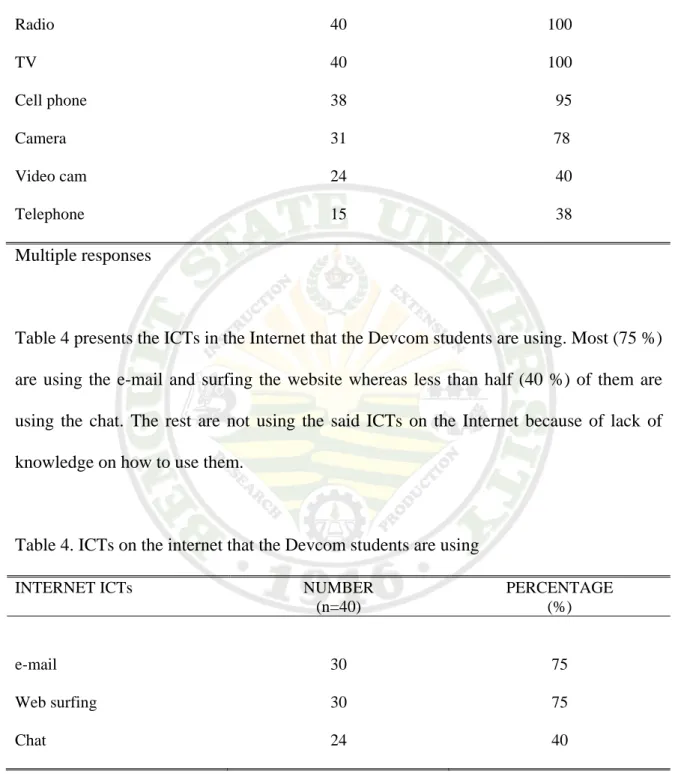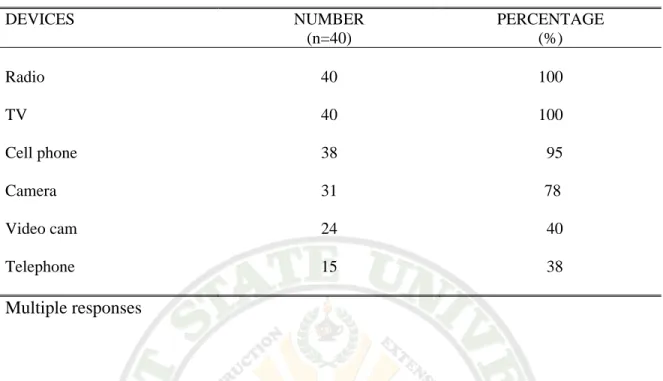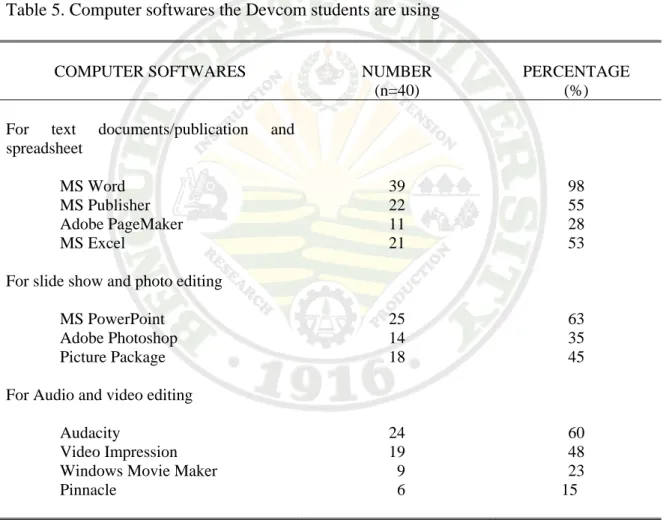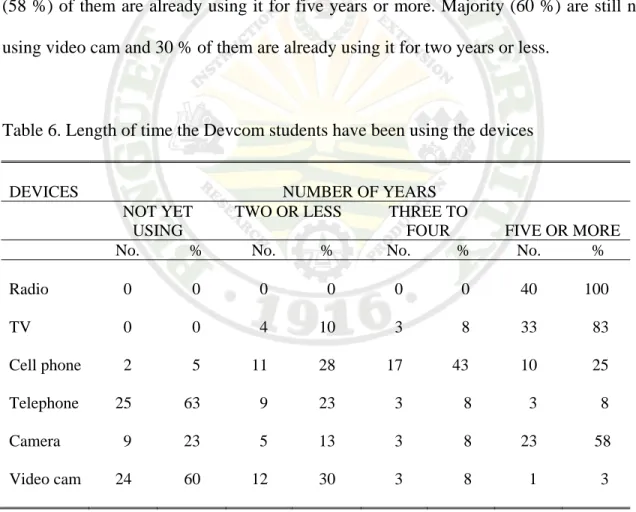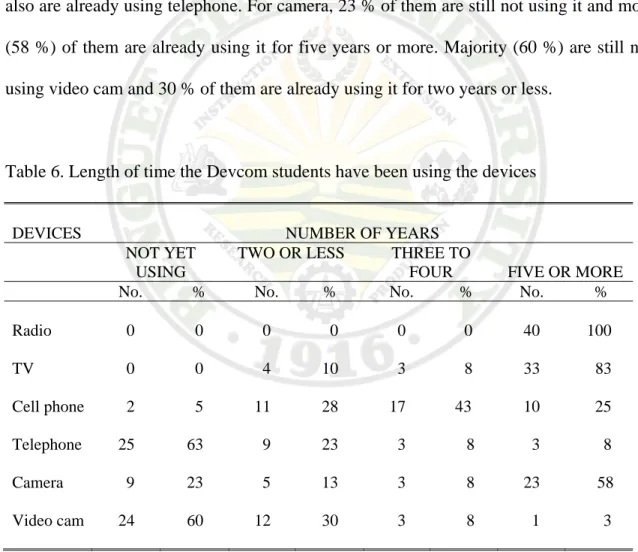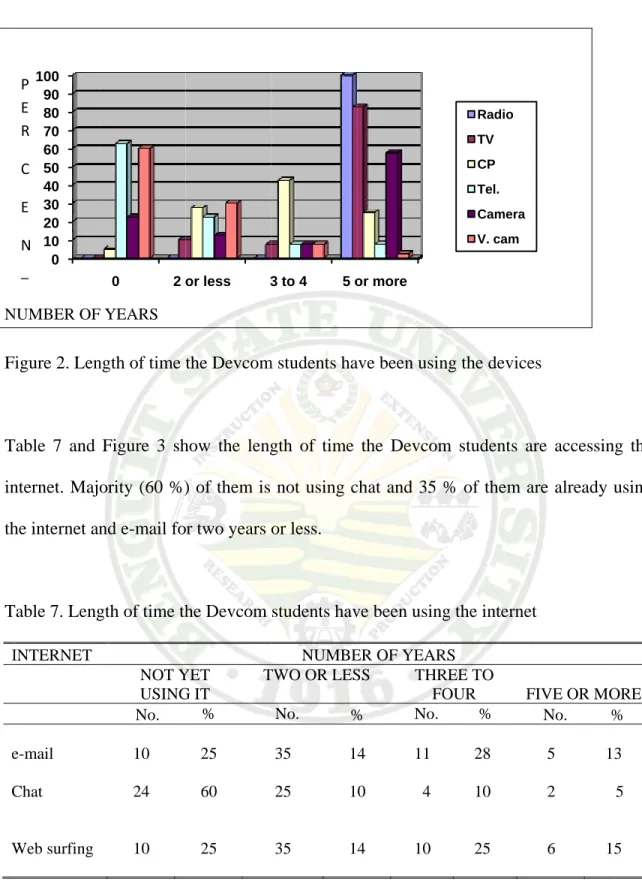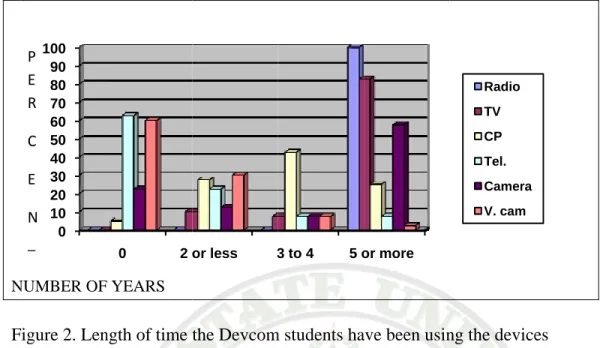ALTATIS, CHAMBERLANE P. APRIL 2007. The Information and Communication Technology (ICT) Usage of Development Communication Students of Benguet State University. Benguet State University, La Trinidad, Benguet.
Adviser: Sheryl I. Fernando, BSc
ABSTRACT
The study was conducted to determine the usage of Information and Communication Technology (ICT) among the Development Communication students of Benguet State University. The specific objectives were to determine the socio- demographic profiles of DevCom students, identify the various ICTs the DevCom students are using., determine the length of time the Devcom students have been using these ICTs., determine how frequent the Devcom students are using these ICTs., determine the level of expertise of Devcom students in using these ICTs., enumerate the information acquired by the Devcom students in using the ICTs., enumerate the positive and negative effects of ICT to the learning strategies and habits of DevCom students.
Survey questionnaire was used in gathering information from 40 respondents.
Most of the respondents were 16-18 years old, and female. Majority of them are from Benguet.
Findings showed that the ICTs the Devcom students are using are devices which includes radio, TV, mobile phone, telephone, camera, and video camera; ICTs on the internet which includes e-mail, chat, and web surfing; and computer softwares which
ii
Movie Maker, Picture Package, Pinnacle, and Audacity. Majority of them, are using the mentioned ICTs but are still not so familiar with how to use some of them. These ICTs also helped them in their learning but it also made them lazy and made their learning expensive.
It is therefore recommended that the Devcom students must be trained with how to use the ICTs, be controlled in using them, and make some alternatives of rersearching.
Page Bibliography………
Abstract………...
Table of Contents ……….………..
INTRODUCTION
Rationale……….
Statement of the Problem………
Objectives of the Study………...
Importance of the Study……….
Scope and Limitation of the Study……….
REVIEW OF LITERATURE
What is ICT?...
ICT in Education……….
ICT in the Philippines………
ICT in Benguet………
Effects of ICT to Learning………
METHODOLOGY
Locale and Time of the Study……….
Respondents of the Study………
Data Collection………
i i iii
1 3 3 4 4
5 5 6 7 8
9 9 9
iv
Data Analysis……….
RESULTS AND DISCUSSION
Socio-Demographic Profile of Devcom Students………..
Various ICTs the Devcom Students are Using………...
Length of Time the Devcom Students
Have Been Using the ICTs………..
Devcom Students’ Frequency of Use
of the ICTs………..
Level of Expertise of Devcom Students
in Using the ICTs………
Information Acquired by the Devcom Students
In Using the ICTs………
The Positive and Negative Effects of ICTs to the
Learning Strategies of Devcom Students………..
SUMMARY, CONCLUSIONS, AND RECOMMENDATIONS
Summary………
Conclusions………
Recommendations……….
LITERATURE CITED………...
APPENDIX: Survey Questionnaire………
11
12 13
16
21
26
31
33
36 37 37 38 40
Rationale
Prior to the advancement of information technologies, communications were done through ideographic or syllabic writing, alphabet writing, and speaking. However, due to the discoveries and inventions of many scientists, technologies on communication were among those that were developed to improve the means of communication through media or technology. These technologies are now used to handle information and aid communication and are called Information and Communication Technology or ICT (Van der Wolf, 2005). ICT is an umbrella term that includes any communication device or application, encompassing: radio, television, cellular phones, computer and network hardware and software, satellite systems and so on, as well as the various services and applications associated with them, such as videoconferencing and distance learning (TechTarget, 2006).
ICT includes telephone, cell phone, radio, TV, video, and computer. More advance technology includes Internet e-mail, chat, website, blog, and pod cast. In more developed countries, they also do video conferencing.
Since the invention of these technologies, they are being adapted by many countries in the world including the Philippines (Manila Times, 2003). At present, the government has been doing a lot of interventions to increase ICT accessibility (Villafania, 2006).
In 1999, the ICT project started at Benguet State University (BSU) in La Trinidad Benguet. It was funded by the Philippine Institutional University Co-operation (PIUC) Program between BSU, Saint Louis University, and several Flemish universities in
The Information and Communication Technology (ICT) Usage of Development Communication Students of Benguet State University / Chamberlane P. Altatis. 2007
Belgium. The project has been identified as the access point of the Philippine research, education and government information network and the regional ICT training and testing center by the Commission on ICT Human Capital Development Group. On June 28, 2006, this project was cited as one of the best “Bridging the Digital Divide” in the Philippines by the Asia Pacific Economic Cooperation Digital Opportunity Center at the awarding ceremonies during the Taipei International Convention Center in Taipei City, Taiwan (Lacsamana, 2006).
Although advanced ICTs like video conferencing is still not applied in La Trinidad, internet surfing and chatting among others are now rampant in the computer shops. Various softwares are also installed in the computers that are being used by students in making projects.
Communication processes take place in the learning environment. Teachers make use of ICT to enhance these communication processes to induce learning. It is then necessary to look into the positive and negative effects of these technologies to guide the teachers and students in making use of them.
ICT is relatively a new concept in developing countries. Study shows that its use in education creates a positive impact to learning.
The Development Communication students of Benguet State University are trained to use some of the ICTs in developing projects, researches, and assignments.
There is a need then to study their ICT usage.
Statement of the Problem
The study aimed to know the ICT usage of the Development Communication students of Benguet State University.
Specifically, the study aims to answer the following questions:
1. What are the socio-demographic profiles of DevCom students?
2. What are the ICTs that the DevCom students are using?
3. How long have the Devcom students been using these ICTs?
4. How frequent are the Devcom students using these ICTs?
5. What is their level of expertise of Devcom students in using these ICTs?
6. What are the information acquired by the Devcom students in using the ICTs?
7. What are the positive and negative effects of ICTs to the learning strategies and habits of DevCom students?
Objectives of the Study
The study aimed to:
1. Determine the socio-demographic profiles of DevCom students;
2. Identify the various ICTs the DevCom students are using;
3. Determine the length of time the Devcom students have been using these ICTs;
4. Determine how frequent the Devcom students are using these ICTs;
5. Determine the level of expertise of Devcom students in using these ICTs;
6. Enumerate the information acquired by the Devcom students in using the ICTs; and
7. Enumerate the positive and negative effects of ICT to the learning strategies and habits of DevCom students.
The Information and Communication Technology (ICT) Usage of Development Communication Students of Benguet State University / Chamberlane P. Altatis. 2007
Importance of the Study
The result of the study will guide the teachers and students in making use of ICTs in the teaching-learning environment. It will also help them in the proper usage and control of these technologies in different learning situations and environment. Moreover, it further enhances the usage of ICT in education.
Scope and Limitation of the Study
The study looked into the ICT usage of the respondents who are Devcom students enrolled for school year 2006-2007 at the Benguet State University.
Data gathering for the study was from January 2007 to February 2007.
REVIEW OF LITERATURE
What is ICT?
Information and Communication Technology - (ICT) The study of the technology used to handle information and aid communication (Van der Wolf, 2005).
ICT (information and communications technology - or technologies) is an umbrella term that includes any communication device or application, encompassing:
radio, television, cellular phones, computer and network hardware and software, satellite systems and so on, as well as the various services and applications associated with them, such as videoconferencing and distance learning. ICTs are often spoken of in a particular context, such as ICTs in education, health care, or libraries (Search.smb.com, 2004.).
Short for Information and Communications Technology, it is the study or business of developing and using technology to process information and aid communications (Webopedia, n.d.).
ICT in Education
The Information and Communication Technology (ICT) curriculum provides students with a broad perspective on the nature of technology, how to use and apply a variety of technologies, and the impact of information and communication technologies on themselves and on society (Alberta Government, 2006).
The use of information and communication technologies (ICTs) in and for education is rapidly expanding in many countries, and is now seen worldwide as both a necessity and an opportunity (UNESCO, 2005).
The Information and Communication Technology (ICT) Usage of Development Communication Students of Benguet State University / Chamberlane P. Altatis. 2007
In the United Kingdom, Information and Communications Technology (ICT) is a subject in education, and a part of the National Curriculum. Other countries, such as Norway, also have ICT as an educational subject. The ICT programme in the United Kingdom is co-ordinated by Becta. A major current initiative is the Curriculum Online scheme which is aimed to accelerate the uptake of technology amongst schools. Becta took over the running of this scheme from the Department for Education and Skills in 2005. Becta works closely with the Joint Information Systems Committee to develop strategy (Wikipedia, n.d.).
ICT in the Philippines
One of the major differences happening in the Philippine ICT education scene now compared to years ago is that the student won't have to wait for a college education to acquire the basic skills in computer technology. One of the main reasons is that basic computer subjects are being taught in grade school at some educational institutions today.
Not only do the elementary school subjects of today teach kids not only how to read, write and do the math but also expose them to an important device they would inevitably use in the future: the PC. Indeed, elementary classrooms offering computer subjects as part of the curriculum will play a major role in fueling the drive of educating the young ones with learning skills using modern technologies as a basic tool (InQ7.net, 2003).
A PUBLISHER of supplementary magazines for high school students in the Philippines for the past 25 years has jumped into the e-learning bandwagon.
Leveraging on its accumulated content, the Diwa Asia Publishing Group Inc. decided this year to aggressively implement an e-learning strategy in a package combining an interactive student resource called "Genyo;" mobile school software; a teacher-training
course on technology; Internet connectivity; and access to an online portal (Asian Journal Online, n.d).
ICT in Benguet
The Seminar-Workshop on Retooling Librarians and Information Managers on Digital Resources, Database Creation, and Management held at the Benguet State University, ICT Hall on February 23-24, 2006 had 68 participants coming from all over the Philippines. The principal objective was to create an awareness of freely available electronic resources on the World Wide Web and to introduce vital database management tools designed by the FAO among librarians and information managers and to develop their skills in applying them to local situations and in contributing local agricultural research results to the AGRIS and PhilAgriNet databases (Anonymous, 2006).
La Trinidad, Benguet: The Benguet State University’s information and communication technology development project was cited one of the best in the Philippines by the Asia Pacific Economic Cooperation Digital Opportunity Center at the awards ceremonies at the Taipei International Convention Center in Taipei City, Taiwan on June 28 (Lacsamana, 2006).
The Information and Communication Technology (ICT) Usage of Development Communication Students of Benguet State University / Chamberlane P. Altatis. 2007
Effects of ICT to Learning
The UK-based BECTA report (2001) Primary Schools of the Future - achieving today analysed results from 2110 schools. It confirmed that schools with very good Information and Communication Technology (ICT) resources had more students achieving at higher levels in national English, Mathematics and Science tests. The Tasmanian study gathered Australian context learning outcomes data and matched this with classroom computer climate information from 63 classes and found a similar effect.
Tension between traditional learning outcomes and student thinking processes when using ICT are described and discussed (Fluck and Robertson, 2002).
ICT can be used to support learning in many different ways in schools. This extends beyond individual pupils’ use of learning software on a computer to include, among other things, interactive presentations using touch sensitive whiteboards, specialist devices like data loggers for the collection of data in science lessons, email based applications to support learning communities and links between schools, and schools’ use of enhanced pupil information systems (Pittard et al., n.d.).
METHODOLOGY
Locale and Time of the Study
The study was conducted at the College of Agriculture (CA), Benguet State University (BSU). As shown in Figure 1, BSU is in La Trinidad, a South-western municipality of Benguet. It is five kilometers away from Baguio City, the summer capital of the Philippines. CA in BSU is chosen as one of the centers of Excellence in Agriculture Education by the CHED.
BSU began as a farm school in June 15, 1916 and gradually developed into a regional state university in 1986. One of the eight colleges of the university is the College of Agriculture. In 1999, the course Bachelor of Science in Development Communication is offered under this college.
The ICT division being in charge in the university handles the overall ICT university Infrastructure. The LAN, network services and Internet services are being maintained. Some ICT services are web hosting for the university official website, email, secure file sharing in the university, e-learning tools and several ICT solutions such as information systems development.
The study was conducted from January 2007 to February 2007.
Respondents of the Study
The respondents of the study were 40 Development Communication students enrolled at BSU in the school year 2006-2007. Ten students per year level were randomly chosen.
F
The Informati
igure 1. Map
ion and Comm
p showing th
munication Tech Students of Be
he locale of t
hnology (ICT) enguet State U
the study
Usage of Dev University / Cha
elopment Com amberlane P. A
mmunication Altatis. 2007
Data Gathered
Data gathered included the socio-demographic profile of DevCom students, the various ICTs they are using, their length of time they have been using these ICTs, their frequency of use of these ICTs, their level of expertise in using these ICTs, the information they are acquiring in using these ICTs, and the positive and negative effects of ICTs to their learning behavior and habit.
Data Analysis
The data collected were analyzed using descriptive statistics. Qualitative data was described in narrative form.
The Information and Communication Technology (ICT) Usage of Development Communication Students of Benguet State University / Chamberlane P. Altatis. 2007
RESULTS AND DISCUSSION
Socio-Demographic Profile of Devcom Students of BSU
The socio-demographic profile of the respondents in this study is of the 40 Devcom students, which is 10 per year level, for the school year 2006-2007. The profile is limited to their age, sex, present address, and provincial address.
Table 1 shows the basic characteristics of the respondents. Their ages range from 16 to 25 years old. The highest rank (45 %) ranges from 16-18 years of age whereas the least (3 %) is the one of 23 and above. Majority (80 %) of them are females and few (20
%) are males.
Table 1. Characteristics of the Devcom students
CHARACTERISTICS NUMBER (n=40)
PERCENTAGE (%) Age
16-18 19-20 21-22 23-25
18 15 6 1
45 38
15 3
TOTAL 40 100
Sex
Male Female
8 32
20 80
TOTAL 40 100
Table 2 presents the places of origin of the respondents. Most (65 %) of them are from Benguet and the rest are from Mountain Province, Baguio, and other places such as Kalinga, Ifugao, and La Union.
Table 2. Places of origin of Devcom students
PLACES OF ORIGIN NUMBER
(n=40)
PERCENTAGE (%)
Benguet Mt. Province Baguio Others
26 10 4 3
65 25 10 8
TOTAL 40 100
Various ICTs the Devcom Students are Using
The various ICTs the Devcom students are using are the devices (radio, TV, cell phone, telephone, camera, video camera); ICTs on the internet (e-mail, chat, and websites); and computer softwares (Microsoft Word, Excel, PowerPoint, Publisher;
Adobe PageMaker, and Photoshop, and others such as Video Impression, Windows Movie Maker, Picture Package, Pinnacle and Audacity).
Table 3 shows the devices the Devcom students are using. All of them are using the radio and TV. The device that fewest number of Devcom students are using on the other hand is the telephone wherein less than half (38 %) of them are using it.
The Information and Communication Technology (ICT) Usage of Development Communication Students of Benguet State University / Chamberlane P. Altatis. 2007
Table 3. Devices the Devcom students are using
DEVICES NUMBER (n=40)
PERCENTAGE (%)
Radio 40 100
TV 40 100
Cell phone 38 95
Camera 31 78
Video cam 24 40
Telephone 15 38
Multiple responses
Table 4 presents the ICTs in the Internet that the Devcom students are using. Most (75 %) are using the e-mail and surfing the website whereas less than half (40 %) of them are using the chat. The rest are not using the said ICTs on the Internet because of lack of knowledge on how to use them.
Table 4. ICTs on the internet that the Devcom students are using
INTERNET ICTs NUMBER
(n=40)
PERCENTAGE (%)
e-mail 30 75
Web surfing 30 75
Chat 24 40
Multiple responses
Table 5 shows the computer softwares that the Devcom students are using. For Microsoft, majority (98 %) of them are using MS Word. On the other hand, the Microsoft software that the least number of Devcom students are using is Excel. For Adobe, 35 % of them are using Photoshop whereas 28 % are using PageMaker. For other softwares, most (60
%) are using Audacity and the software that the least number of Devcom students are using is Pinnacle wherein only 15 % of them are using it.
Table 5. Computer softwares the Devcom students are using
COMPUTER SOFTWARES NUMBER (n=40)
PERCENTAGE (%) For text documents/publication and
spreadsheet
MS Word
MS Publisher Adobe PageMaker
MS Excel
39 22 11 21
98 55 28 53 For slide show and photo editing
MS PowerPoint Adobe Photoshop Picture Package
25 14 18
63 35 45 For Audio and video editing
Audacity
Video Impression Windows Movie Maker Pinnacle
24 19 9 6
60 48 23 15 Multiple responses
The Information and Communication Technology (ICT) Usage of Development Communication Students of Benguet State University / Chamberlane P. Altatis. 2007
Length of Time the Devcom Students Have Been Using the ICTs
Table 6 and Figure 2 present the length of time the Devcom students are already using the devices. The longest time that was already used by them is radio wherein all of them are already using it for five years or more. On the other hand, the device that most (63 %) of them are not using is telephone. Majority (83 %) of them also have been using TV for five years or more. For cell phone, 28 % of them are already using it for two years or less and 25 % of them are already using it for five years or more. Only 23 % of them also are already using telephone. For camera, 23 % of them are still not using it and most (58 %) of them are already using it for five years or more. Majority (60 %) are still not using video cam and 30 % of them are already using it for two years or less.
Table 6. Length of time the Devcom students have been using the devices
DEVICES NUMBER OF YEARS
NOT YET USING
TWO OR LESS THREE TO
FOUR FIVE OR MORE No. % No. % No. % No. % Radio 0 0 0 0 0
0 40 100 TV 0 0 4 10 3 8 33 83 Cell phone 2 5 11 28 17 43 10 25 Telephone 25 63 9 23 3 8 3 8 Camera 9 23 5 13 3 8 23 58 Video cam 24 60 12 30 3 8 1 3
F
T in th
T I
e C
W
N
igure 2. Len
Table 7 and nternet. Majo he internet an
Table 7. Leng INTERNET
e-mail Chat
Web surfing
NUMBER OF 0 10 20 30 40 50 60 70 80 90 P 100 E R C E N T
ngth of time
Figure 3 sh ority (60 %) nd e-mail fo
gth of time th
NOT Y USING No.
10 24
10 YEARS
0 2
the Devcom
how the leng ) of them is or two years
he Devcom
YET G IT
T
% 25
60
25
or less 3
m students ha
gth of time not using c or less.
students hav NUMBE TWO OR LES No. % 35 1 25 1
35 1 3 to 4 5 o
ave been usin
the Devcom chat and 35
ve been using ER OF YEAR SS THR FO
% No.
4 11 0 4
4 10 or more
ng the device
m students a
% of them a
g the interne RS
REE TO OUR F
% 28 10
25
Radio TV CP Tel.
Camera V. cam
es
are accessin are already u
et
FIVE OR MO No. %
5 1 2
6 1
g the using
ORE
% 3
5
5
F
T th th n th P o u tw
The Informati
igure 3. Len
Table 8 and F he software hem are alre ot yet using hem are not owerPoint fo f them are a sing the Pin wo years or l
NU 0 10 20 30 40 50 60 P E R C E N T
ion and Comm
ngth of time
Figures 4, 5, for text doc eady using W g the Photos
t yet using for five years lready using nnacle. Furth less and less UMBER OF Y
0
munication Tech Students of Be
the Devcom
and 6 show uments or p Word for five
shop. For th the Photosh s or more. Fo g the Audaci hermore, maj
s than half (4 YEARS
2 or less
hnology (ICT) enguet State U
m students ha
w the length o publication a
e years or m he slide show
hop and onl or the audio ity for two y
jority (60 % 48 %) for Vi
3 to 4
Usage of Dev University / Cha
ave been usin
of time in us and spreadsh more wherea
w and photo ly 10 % of and video e ears or less
%) of them ar deo Impress
5 or mor
elopment Com amberlane P. A
ng the intern
sing comput heet, less tha s majority (7 o editing ma
them are a diting, more and 34 % of re already us sion.
re
mmunication Altatis. 2007
net
ter softwares an half (45 %
73 %) of the ajority (65 % already using e than half (6
f them are no sing Audacit
e-mail chat website
s. For
%) of em is
%) of g the 60 %)
ot yet ty for
Table 8. Length of time the Devcom students have been using the computer softwares
SOFTWARE NUMBER OF YEARS
NOT YET
USING TWO OR LESS
THREE TO FOUR
FIVE OR MORE No. % No. % No. % No. % For text
document/publication and spreadsheet
Word 1 3 10 25 11 28 18 45
Publisher 18 45 19 48 3 8 0 0 PageMaker 29 73 9 23 2 5 0 0 Excel 19 48 12 30 4 10 5 13 For slide show and
photo editing
PowerPoint 15 38 16 40 5 13 4 10 Photoshop 26 65 13 33 1 3 0 0 Picture
Package
22 55 18 45 0 0 0 0
For audio and video editing
Audacity 16 40 24 60 0 0 0 0 Video
Impression 21 53 19 48 0 0
0 0 Movie Maker 31 78 9 23 0 0 0 0
Pinnacle 34 85 6 15 0 0 0 0
F d
F an
The Informati
Figure 4. Le
ocuments/pu
igure 5. Le nd photo edi
0 10 20 30 40 50 60 70 80
0 10 20 30 40 50 60 70 P E R C E N T
P E R C E N T
ion and Comm
ength of tim ublication an
NUMBE
ength of time iting
0
0
munication Tech Students of Be NUMBER
me the Devco nd spreadshe
ER OF YEAR
e the Devco
2 or less
2 or less
hnology (ICT) enguet State U R OF YEARS
om students eet
RS
m students h
3 to 4
3 to 4
Usage of Dev University / Cha
S
s have been
have been us
5 or mo
5 or more
elopment Com amberlane P. A
using the s
sing softwar
ore
Pow Pho Pict
mmunication Altatis. 2007
oftwares for
res for slide
Word Publisher PageMaker Excel
werPoint otoshop
ure Package
r text
show
r
F v
D
th u w T M M th u
igure 6. Th ideo editing
Devcom Stud Frequ hey are usin sing it once weekly.
Table 9 and Majority (90 More than ha
hem are also sing video c
0 10 20 30 40 50 60 70 80 P 90
E R C E N T
NUMBE
he Length of
dents’ Freque uency of use ng it daily, w
in a while,
Figure 7 sh
% and 70 % alf (63 %) of o using TV a cam 40 % of
0
ER OF YEAR
f time the De
ency of Use of Devcom weekly, or when it is o
how how fre
%) of them f them are no and cell phon f them are us
2 or less RS
evcom stude
of the ICTs m students is
occasionally nly needed,
equent the D are using th ot using the ne daily. Mo ing it occasi
3 to 4
ents are using
indicated w y. Occasiona and other fr
Devcom stu he radio and
telephone. M ore than half ionally.
5 or more
g the softwa
whether they ally, include requency of
udents are us d TV every Majority (70 f (55 %) of t
Aud Vid Mov Pin
ares for audio
y are not usin es those wh
their use be
sing the dev day respecti 0 % and 95 %
them are als
dacity
eo Impressio vie Maker
nacle
o and
ng it, o are eyond
vices.
ively.
%) of so not
on
T
D
R T C T C V
F
The Informati
Table 9. Devc DEVICES
Radio TV Cellphone Telephone Camera Videocam
igure 7. Dev
0 10 20 30 40 50 60 70 80 90 P 100 E R C E N T
ion and Comm
com student
NOT USI IT No.
1 0 0 25 6
4 1 22 5
vcom studen
Not using
munication Tech Students of Be
s’ frequency
ING OCC
% No 0 3 0 6 0 1 63 12 10 30 55 16
nts’ frequenc FREQUENC
Occasion
hnology (ICT) enguet State U
y of use of th FREQUE CASIONALL
o. %
8 15
3 30 8 40
y of use of t CY OF USE nally Da
Usage of Dev University / Cha
he devices ENCY OF U LY DA
No.
32 28 38 1 1 0
the devices
ily W
elopment Com amberlane P. A
SE AILY
% 90 70 95 3 3 0
Weekly
mmunication Altatis. 2007
WEEKLY No.
5 6 1
2 5
2
Radio TV CP Tel.
Camera V. cam
Y
% 13 15 3 5 13
5
a
T M m th
T I T
e C W s
F
Table 10 and Most (60 %) mail weekly, he net occasi
Table 10. Dev INTERNE T
e-mail Chat Website surfing
igure 8. Dev
0 5 10 15 20 25 30 35 40 45 P 50 E R C E N T
d Figure 8 pr of them are and 25 % ar ionally, 40 %
vcom studen
NOT USIN No.
10 16
10
vcom studen
Not using
resent how f e not using c re surfing th
% for chat, an
nts’ frequenc
NG IT OC %
25 40
25
nts’ frequenc FREQ Occasiona
frequent the chat in comp e websites. L nd 38 % for
cy of use of t
FRE CCASIONAL No. % 15 3
16 4
19 4
y of use of t QUENCY
ally Da
Devcom stu puter interne
Less than ha e-mail.
the ICTs on
EQUENCY LLY D
% No.
8 3 40 3
48 3
the ICTs on t
ily W
udents are u t, 35 % are alf (48 %) of
the Internet
DAILY
% 1 1
1
the internet
Weekly
using the inte checking th f them are su
WEEKL No.
14 7
10
e-m Cha Web
ernet.
eir e- urfing
LY
% 35 18
25
ail at
bsite
The Information and Communication Technology (ICT) Usage of Development Communication Students of Benguet State University / Chamberlane P. Altatis. 2007
Table 11 and Figures 9, 10, and 11 shows how frequent the Devcom students are using the computer softwares. For the softwares for text documentation/publication and spreadsheet, 48 % of them are using Word weekly and 50 % of them are using Excel occasionally. For the softwares for slide show and photo editing, 55 % of them are not using Picture Package and 48 % of them are using the PowerPoint occasionally. For the softwares for audio and video editing, 60 % of them are using the audacity occasionally and 85 % of them are not using the Pinnacle.
Table 11. Devcom students’ frequency of use of computer softwares
SOFTWARE FREQUENCY Not Using it Occasionally Everyday Weekly
No. % No. % No. % No. %
For text
documents/publication and spreadsheet
Word 1 3 13 33 7 18 19 48 Publisher 18 45 18 45 0 0 2 5 PageMaker 20 50 15 38 0 0 5 13 Excel 15 38 20 50 1 3 4 10 For slide show and
photo editing
PowerPoint 19 48 19 48 0 0 2 5 Photoshop 26 65 11 28 0 0 3 8 Picture Package 22 55 18 45 0 0 0 0 For audio and video
editing
Audacity 16 40 24 60 0 0 0 0 Video
Impression 21 53 19 48 0 0 0 0 Windows
Movie Maker 31 78 9 23 0 0 0 0 Pinnacle 34 85 6 15 0 0 0 0
F an
F
igure 9. Dev nd spreadshe
igure 10. De
0 5 10 15 20 25 30 35 40 45 50
N
0 10 20 30 40 50 60 70
N P
E R C E N T
P E R C E N T
FR
vcom studen eet
FR
evcom’s freq
Not Using it
Not Using it
REQUENCY
nts’ frequenc
REQUENCY
quency of us Y
y of use of s
Y
se of the soft
Daily
Daily
softwares for
twares for sl
r text docum
ide show an
P P P
ment/publicat
nd photo edit
Word Publisher PageMak Excel
PowerPoint Photoshop Picture Packag
tion
ting
r er
ge
F
L in T d o
T D
R T C T C V
0 1
The Informati
igure 11. De
Level of Expe n Using the I Table 12 and evices. All o f them does
Table 12. Lev DEVICES
Radio TV Cellphone Telephone Camera Videocam
Rating - no experien -3 – Poor (o
0 10 20 30 40 50 60 70 80
P 90
E R C E N T
ion and Comm FR evcom ‘s fre
ertise of Dev ICTs
Figure 12 p of them are g
not know ho
vel of expert
NO EXPERIEN
No.
0 0
0 25 4 24 g scale:
nce at all nly knows th
Not Using it
munication Tech Students of Be REQUENCY quency of u
vcom Studen
present the le good in usin ow to use tel
tise of Devco
NCE
% No 0 0 0 0
0 0
63 1 10 4 60 3
he basics)
Occasionally
hnology (ICT) enguet State U Y
se of the sof
nts
evel of exper ng radio, TV lephone and
om students LEVEL O POOR
o. % 0 0 0 0 0 0 3 10 3 8
4-6 – Aver 7-10 – Goo
y Daily
Usage of Dev University / Cha
ftwares for a
rtise of the D V, and cell ph video cam r
in using the OF EXPERTI AVERA No.
0 0 0 3 10 9
age (not so g od (almost ex
Weekly
elopment Com amberlane P. A
audio and vid
Devcom stud hone. Most ( respectively.
e devices ISE AGE
% N
0 0 0
8 25 23
good and no xpert)
y
mmunication Altatis. 2007
deo editing
dents in usin (63 % and 6 .
GOOD No. %
40 10 40 10 40 10
11 2
22 5
4 1
ot so poor)
Audacity Video Impres Movie Maker Pinnacle
ng the 60 %)
% 00 00 00 28 55 10
ssion
F
T in (6
T
I
e C W
igure 12. Le
Table 13 and nternet: 45 % 60 %) of the
Table 13. Le
INTERNET
e-mail Chat Website
0 10 20 30 40 50 60 70 80 90 100
P E R C E N T
LE evel of exper
d Figure 13
% of them a m does not k
evel of exper
N EXPER No.
10 24 10
No ex…
EVEL OF EX rtise of Devc
present the re good in u know how to
rtise of Devc
NO RIENCE
% 25 60 25
Poor
XPERTISE com students
level of exp using e-mail o use chat.
com students
LEVEL POOR No. %
5 13
0 0
2 5
Aver
s in using the
pertise of D l and websit
s in using the
L OF EXPER AV
% No.
3 7 0 6 5 10
rage
e devices
Devcom stud e surfing an
e Internet
TISE VERAGE
% 18 15 25
Good
dents in usin nd more than
GOOD No.
18 10 18
Radio TV Cellp Telep Came Video
ng the n half
D
% 45 25 45
o
hone phone
era ocam
F
T u sp
% an th au 1 th o
The Informati
igure 13. Le
Table 14 and sing the co preadsheet, m
%) of them h nd photo ed han half (65 udio and vid 3 % of them hem are also f them are p
0 10 20 30 40 50
P 60
E R C E N T
ion and Comm L
evel of exper
d Figures 14 omputer so majority (85 have no expe diting, 43 % %) of them deo editing, m are leveled o average in oor in using
No ex…
munication Tech Students of Be LEVEL OF EX
rtise of Devc
4, 15 and 16 oftwares. Fo 5 %) of them erience in us of them are m have no ex
majority (85 d 7-10 (good
using Video g Audacity an
Poor
hnology (ICT) enguet State U
XPERTISE
com students
6show the le or software m are leveled
ing the Paga e leveled 7-1 xperience in 5 %) of them d) in using V
o Impression nd 23 % in M
Averag
Usage of Dev University / Cha
s in using the
evel of expe s for text
7-10 (good) aMaker. For 10 (good) in n using Phot m have no ex Video Impres
n and 20 % i Movie maker
ge Goo
elopment Com amberlane P. A
e internet
ertise of Dev documents/
) in using W r the softwar n using Powe
toshop. For t xperience us ssion. Twent in Audacity.
r.
od
mmunication Altatis. 2007
vcom studen /publication Word and mos res for slide
erPoint and the software sing Pinnacle
ty-five perce Moreover,
e-mail Chat Website
nts in and st (73 show more es for e and ent of 40 %
Table 14. Level of expertise of Devcom students in using the computer softwares
SOFTWARE LEVEL OF EXPERTISE
NO EXPERIENCE
POOR AVERAGE GOOD No. % No. % No. % No. % For text
documents/publication and spreadsheet
Word 1 3 0 0 5 13 34 85 Publisher 18 45 0 0 11 28 6 15 PageMaker 29 73 3 8 8 20 0 0 Excel 19 48 3 8 6 15 12 30 For slide show and photo
editing
PowerPoint 15 38 0 0 8 20 17 43 Photoshop 26 65 5 13 7 18 2 5 Picture Package 22 55 0 0 4 10 14 35 For audio and video
editing
Audacity 16 40 16
40 8 20 0 0 Video
Impression 21 52 4 10 10 25 5 13
Movie Maker 31 78 9 23 0 0 0 0 Pinnacle 34 85 6 15 0 0 0 0
F d
F an
The Informati
igure 14. L ocuments/pu
igure 15. Le nd photo edi
0 10 20 30 40 50 60 70 80 90
0 10 20 30 40 50 60 70
P E R C E N T
P E R C E N T
ion and Comm LE
Level of ex ublication an
LE
evel of expe iting
No ex…
No ex…
munication Tech Students of Be EVEL OF EX
xpertise of D nd spreadshe
EVEL OF EX
ertise of Dev Poor
Poor
hnology (ICT) enguet State U XPERTISE
Devcom stu eet
XPERTISE
vcom studen Averag
Average
Usage of Dev University / Cha
udents in u
nts in using
e Goo
Good
elopment Com amberlane P. A
using the so
the software d
Pow Phot Pictu
mmunication Altatis. 2007
oftwares for
es for slide
Word Publishe PageMak Excel
werPoint toshop ure Package
r text
show
er ker
F v
In S T st in th th (4 th
Figure 16. L ideo editing
nformation A tudents in U Table 15, Fi tudents in us nternet. All o hem are acq hem also are 40 % and 48 hem are also
0 10 20 30 40 50 60 70 80 90
N P
E R C E N T
LEVEL O
Level of exp
Acquired by Using the ICT
igure 17, an sing the ICT of them are a quiring enter
e acquiring p 8%) of them
acquiring p
No ex…
OF EXPERTIS
pertise of De
the Devcom Ts
nd Figure 1 Ts. Majority acquiring ne rtainment fro personal me
are acquirin personal mes
Poor A
SE
evcom stude
m
8 show the (90 %) of th ews in using om TV and ssages in us ng researches sage in usin
Average
ents in using
e informatio hem are acqu
radio and T d radio respe sing cell pho s from radio g chat and 4
Good
g the softwar
on acquired uiring resear TV. Most (95
ectively. Ma one. Moreov and TV resp 40 % for e-m
Auda Video Movie Pinna
res for audio
by the Dev rches in usin 5 % and 80 % ajority (95 % ver, less than
pectively. H mail.
acity
o Impression e Maker acle
o and
vcom ng the
%) of
%) of n half alf of
T
I
R T C T C V I
s M
F P E R C E N T
The Informati
Table 15. Info ICT
Radio TV Cell phone Telephone Camera Videocam Internet
e-mail chat Web surfing
Multiple res
igure 17. Inf
2 4 6 8 10
ion and Comm
ormation acq
Research No. %
16 4 19 4 4 1
2 8 2 5 1
10 2 2
36 9 sponses
formation ac INFORMA
0 0 0 0 0 0
Research
munication Tech Students of Be
quired by De
hes Ente
% No.
40 32 48 38
0 8 5 2 20 6 3 5
25 12 5 10
90 9
cquired by th ATION ACQ
hes Enter
hnology (ICT) enguet State U
evcom stude INFORMAT rtainment
% 80 95 20 5 15 13
30 25
23
he Devcom s QUIRED
r... New
Usage of Dev University / Cha
ents in using TION ACQU
News No.
40 1 40 1 9
3 1 0
9 5
11
students in u
ws P. Me
elopment Com amberlane P. A
the ICTs UIRED
Pe
% N
00 00 23 38
8 1
3
0
23 1
13 2
28
using the dev
essages R TV C Te C V
mmunication Altatis. 2007
rsonal Messa No. %
0 0
0 0
8 95 11 28
3 8
2 5
16 40 20 50
0 0
vices
Radio V
P el
amera . cam
age
0 0 5 8 8 5
0 0
0
